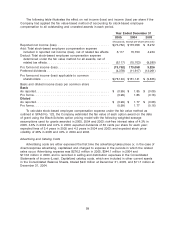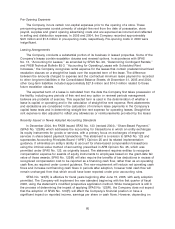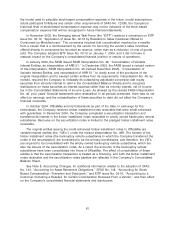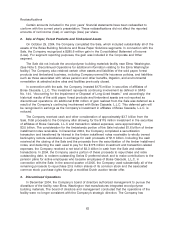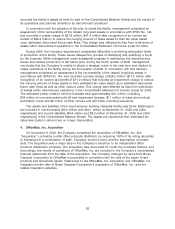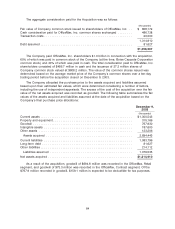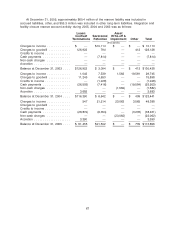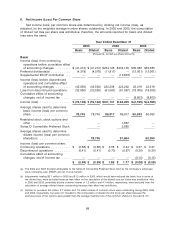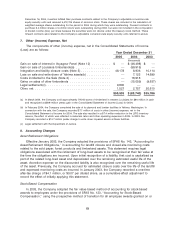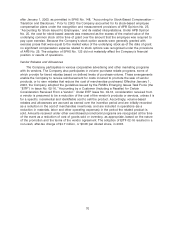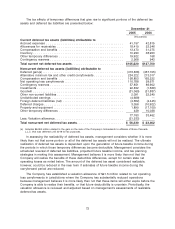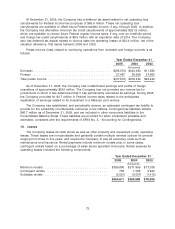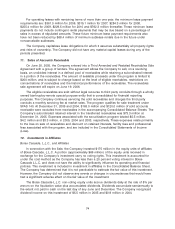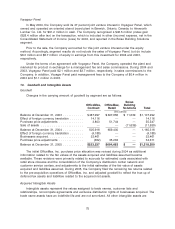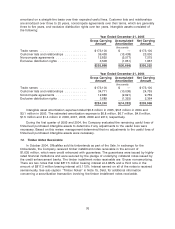OfficeMax 2005 Annual Report Download - page 73
Download and view the complete annual report
Please find page 73 of the 2005 OfficeMax annual report below. You can navigate through the pages in the report by either clicking on the pages listed below, or by using the keyword search tool below to find specific information within the annual report.
December 16, 2004, investors fulfilled their purchase contracts related to the Company’s adjustable conversion-rate
equity security units and received 5,412,705 shares of common stock. These shares are included in the calculation of
weighted average shares outstanding for the period in 2004 during which they were outstanding. Forward contracts to
purchase 5.4 million shares of common stock were outstanding during 2003, but were not included in the computation
of diluted income (loss) per share because the securities were not dilutive under the treasury stock method. These
forward contracts were related to the Company’s adjustable conversion-rate equity security units referred to above.
7. Other (Income) Expense, Net
The components of other (income) expense, net in the Consolidated Statements of Income
(Loss) are as follows:
Year Ended December 31
2005 2004 2003
(thousands)
Gain on sale of interest in Voyageur Panel (Note 12) .......... $ — $(46,498) $ —
Gain on sale of Louisiana timberlands(a) ................... — (59,915) —
Integration and facility closure costs (Note 5) ................ 48,178 8,936 10,114
Loss on sale and write-down of Yakima assets(b) ............. — 7,123 14,699
Costs incidental to the Sale (Note 2) ...................... — 18,916 —
Gains on sales of other timberlands ...................... — (15,059) (9,637)
Legal settlement(c) ................................... 9,800 — —
Other, net ......................................... 1,527 2,757 20,610
$59,505 $ (83,740) $35,786
(a) In March 2004, the Company sold approximately 79,000 acres of timberland in western Louisiana for $84 million in cash
and recognized a $59.9 million pretax gain in the Consolidated Statement of Income (Loss) for 2004.
(b) In February 2004, the Company completed the sale of its plywood and lumber facilities in Yakima, Washington. In
connection with the sale, the Company recorded $7.1 million of costs in other (income) expense, net in the
Consolidated Statement of Income for 2004. The sale also resulted in a $7.4 million reduction in the LIFO inventory
reserve, the effect of which was reflected in materials, labor and other operating expenses in 2004. In 2003, the
Company recorded a $14.7 million pretax charge to write down impaired assets at these facilities.
(c) Legal settlement with the Department of Justice.
8. Accounting Changes
Asset Retirement Obligations
Effective January 2003, the Company adopted the provisions of SFAS No. 143, ‘‘Accounting for
Asset Retirement Obligations,’’ in accounting for landfill closure and closed-site monitoring costs
related to the sold paper, forest products and timberland assets. This statement requires legal
obligations associated with the retirement of long-lived assets to be recognized at their fair value at
the time the obligations are incurred. Upon initial recognition of a liability, that cost is capitalized as
part of the related long-lived asset and depreciated over the remaining estimated useful life of the
asset. Accretion expense on the discounted liability is also recognized over the remaining useful life
of the asset. Previously, the Company accrued for estimated closure costs over the life of the landfill
and expensed monitoring costs as incurred. In January 2003, the Company recorded a one-time
after-tax charge of $4.1 million, or $0.07 per diluted share, as a cumulative-effect adjustment to
record the effect of initially applying this statement.
Stock-Based Compensation
In 2003, the Company adopted the fair value-based method of accounting for stock-based
awards to employees under the provisions of SFAS No. 123, ‘‘Accounting for Stock-Based
Compensation,’’ using the prospective method of transition for all employee awards granted on or
69


